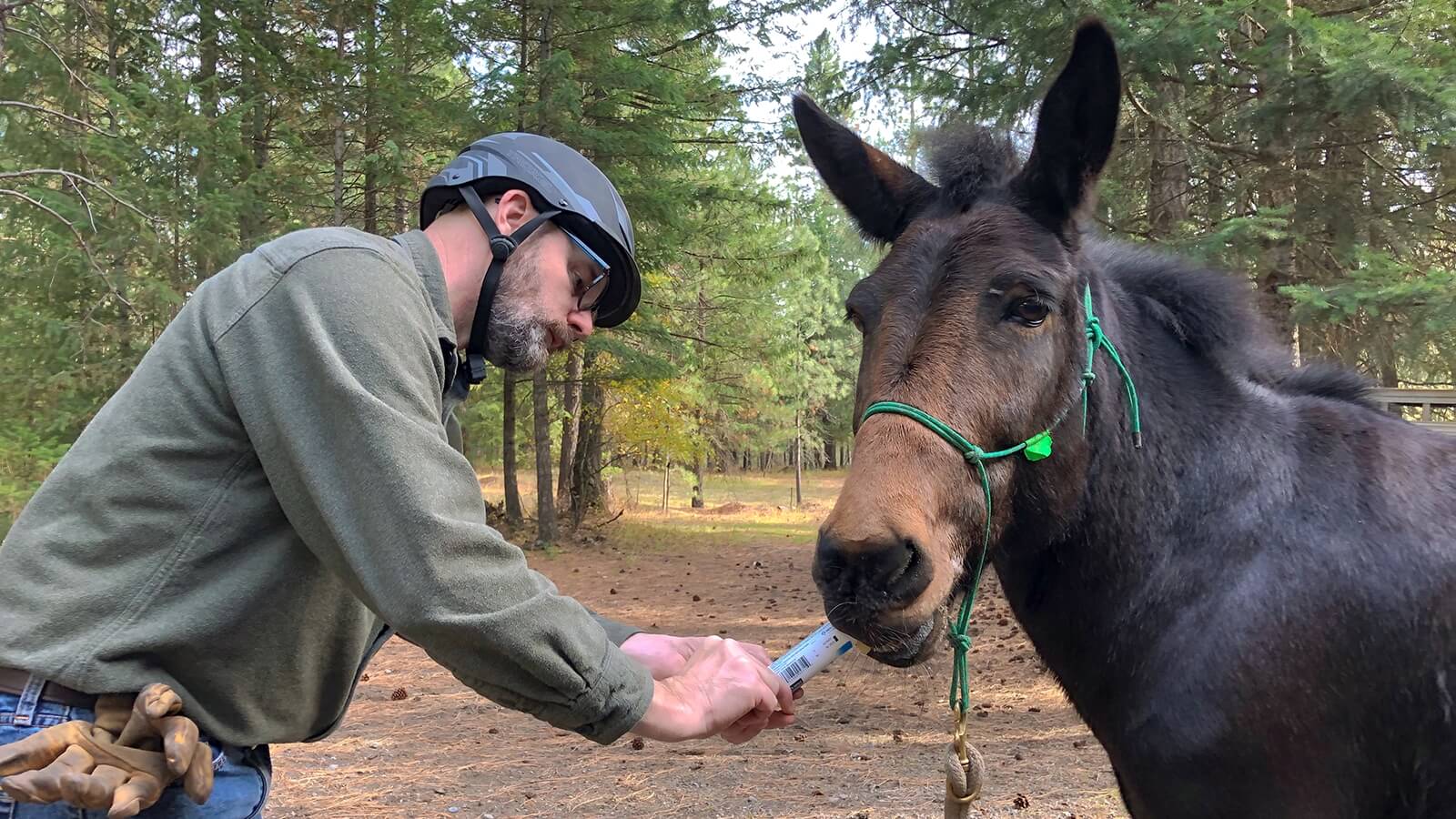Deworming used to be an ordeal that neither the horses nor I enjoyed. I would sneak up to the horse, grab the halter tight, and jam the dewormer tube in his mouth. It was a vain attempt to get the job done quickly before the inevitable fight. Not only did this make the horse defensive, but it also made the process downright dangerous. Deworming days were dreaded by all involved. It doesn’t have to be this way.
I now look at deworming as an ongoing process, not an event to be avoided. If you take the time to make administering oral medications a regular part of your routine, the process can become much more manageable and worry-free. My goal is for deworming to be a casual kind of event—no worries, no fuss, and most importantly, no drama. Here are four steps I use to get my animals to relax and accept their meds.
- Accept the Tube
The first step is getting your equine used to having the tube around him. I rub an empty applicator all over him. If he fights it, I hold the tube on him until he stops resisting then I take it away. Approach and retreat are key here. As soon as the horse stops moving, remove the tube.
I’ve had horses who, in the beginning, I couldn’t even approach with the tube. In those cases, I start by just standing near them and then slowly progress to touching them. Take your time and be relaxed.
- Add the Sweet Stuff
Once your horse can tolerate having an empty tube resting on his face without any fuss, it’s time to up the ante and ask him to take the tube in his mouth. It helps to have the tube filled with something good. I like using applesauce. Fill an empty dewormer, or a similar type of tube, with applesauce. Don’t bother wiping off any residue. Gently place the tube near the horse’s mouth so he can smell and taste the applesauce on the outside.
As the horse learns that the tube contains something yummy, you’ll be able to gently depress the plunger and squirt the contents into his mouth. Repeat this practice, “deworming” with the good stuff until the process is smooth and easy. Now, when my horses see a deworming tube, they come running for their treat.
- Deworm
Once your animals are excited and happy to see the deworming tube, it’s time to use something that reduces internal parasites better than applesauce. Now is the time to use a little deception (then a lot of apologies).
Before heading out with a real dewormer, smear the outside with applesauce and fill an empty tube with applesauce. The coating on the outside of the real dewormer will help disguise the foul smell and taste until it’s too late, and the applesauce-filled tube serves as an apology.
Always end on a positive note. If you administer the nasty medication and finish the process there, your horse will remember it longer than you.
- Return to the Sweet Stuff
To reinforce the idea that 99.9% of the time a dewormer tube is a good thing, I follow up with applesauce shots for the next few days after applying a real dewormer until, once again, the ponies come running when they see the tubes. Once a month, I break out the applesauce tubes to keep the good vibes going.
I rely on my horses and mules to get me into wild and fabulous places. Part of preparing them for that requires regular preventive medical care, including deworming or administering any oral medications. I want my animals to trust me. I work towards that goal by making what used to be an unpleasant experience something to be enjoyed.
For more practical information on trail riding and camping with horses, visit me at www.TrailMeister.com. From the TrailMeister website, you can not only surf the world’s most extensive guide to horse trails and camps, but you can also order my new book, The ABCs of Trail Riding and Camping with Horses. It covers 178 topics of essential knowledge for horse owners, from training tips to outdoor skills to increase your safety and fun on the trail and in camp.
See this article in the May/June 2022 online edition:

Robert Eversole, ”the trail meister,” owns www.TrailMeister.com, the largest database of horse riding and camping areas in the U.S. with free trail and trailhead information, trail maps, and much more to help horse enthusiasts experience the joys of trail riding. Robert is a registered riding instructor with PATH International, a mounted search and rescue team member, and a U.S. Marine who has served on the board of the Backcountry Horsemen of Washington (BCHW). He is enjoying his new career helping fellow trail riders stay found and safe on the trail. When not on the trail, The Trail Meister resides near Spokane, WA and teaches land navigation to a wide variety of outdoor groups across the nation. For North America’s largest horse trail and camping directory, trail tips, and more, visit www.TrailMeister.com.

